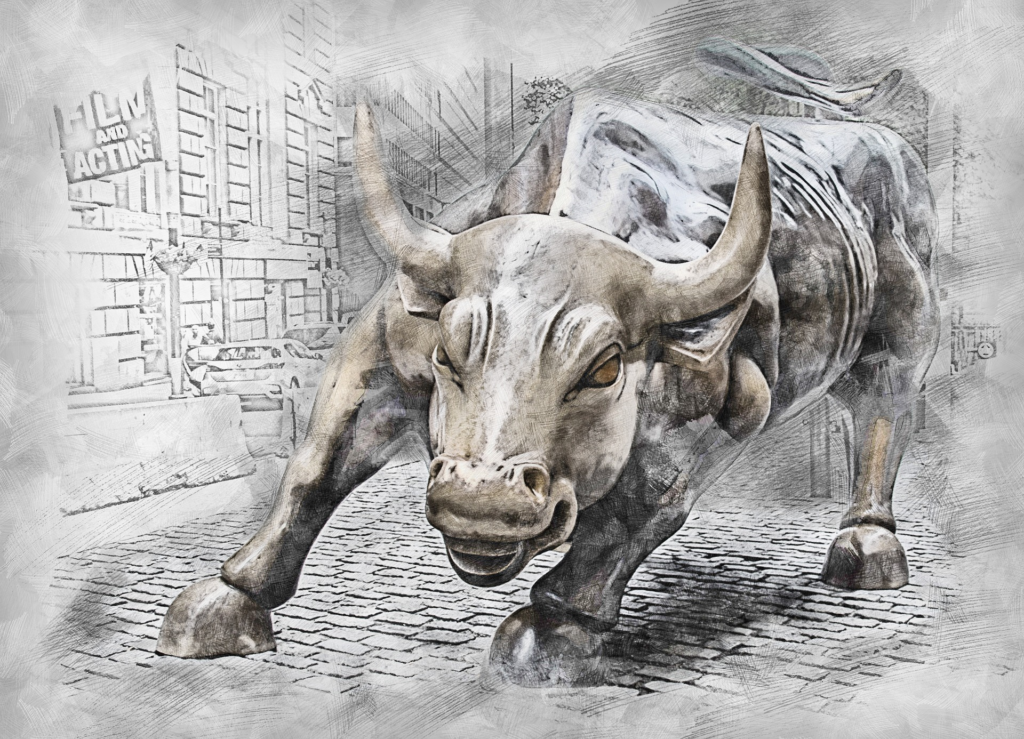Definition of a bull market: a prolonged period of optimism and price increases in the financial markets.
What is a bull market?
A bull market is a prolonged period of price growth in a financial market, such as the stock market.
A bull market is typically measured from the lowest price point in the previous bear market, to the highest price point achieved before the next bear market sets in.

A great tribute to the bull market comes in the form of a giant bull statue which is located outside the New York Stock Exchange on Wall St (pictured above). This has become a must-see tourist attraction for visitors to the financial district.
Where does the phrase ‘bull market’ come from?
‘Bull market’ describes a market condition where prices are rising, whereas the phrase bear market is used to describe the opposite scenario where prices are generally falling.
Both market conditions take their name from an animal, which was coined to reflect the investor sentiment of each. There are some different theories as to the precise origin.
Some point to the way that a bull thrusts its horns upward in its attack, whereas bears swipe their large claws downwards.
Others link the term ‘bear’ to sellers of bear skins, and claim that the term became broader, to refer to sellers in general over time.
The terms bull and bear are also used to describe market participants with positive or negative expectations.
Bulls are the optimistic investors who pile money into the market in the hope of excellent returns. Investors with this mindset are either called ‘bulls’ or are said to be ‘bullish’.
Pessimists are known as ‘bears’ or ‘bearish’ in the investing world.
How is the phrase financial statements used in a sentence?
“The bull market has run its course, and now we’re seeing bearish sentiments creeping back into the markets.”
When was the most recent bull market?
The most recent stock market bull market at the time of writing, was the strong recovery in equities after the April 2020 stock market crash triggered by the global pandemic.
The S&P 500 since rose by a whopping 51% from its lowest point, to actually beat its previous high, by August 2020.
This bull market was especially short – usually it takes years for a stock market to recover from a crash. This made the rally particularly notable.
It was later discovered that the boom in equity markets and tech stocks, in particular, may have been spurred on by the vast purchases of bullish equity options by Japanese investment house Softbank over the summer of 2020.
Prior to the 2020 bounce-back, the global stock market had enjoyed a long and steady bull market stretching across almost the entire 2010 – 2019 decade, which ended in March 2020. Over this time, the value of the market increased by 400.5% from trough to peak.
How does the definition of bull markets relate to investing?
Bull markets are synonymous with high investment returns. Quite naturally, investors enjoy investing during bull markets, because it can often feel like their investment portfolio continues to show fresh gains each time they log on!
However, as the best investment books will point out, it’s actually very useful to invest during a bear market period where prices are low. This will result in low dollar-cost-averaging across your purchases, ensuring that you will make the maximum return when prices eventually rise.
To think about it from another angle – if you invest during the final year of a long bull market, you are actually investing at a relatively high price point, relatively speaking.
The implication is that if you invest in shares during the late stages of a bull market, you aren’t getting good value for your money. Followers of the value investing strategy and dividend growth investing strategy would be put off by this prospect. However, growth investors are typically happier to pay a premium.